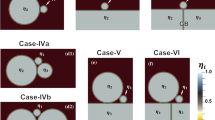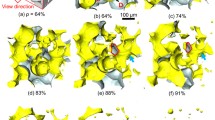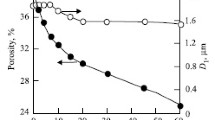Abstract
This article shows how percolation theory provides a theoretical model for the onset of shape distortion in liquid-phase sintering. The model uses an equivalent bond number per grain, with bond strength depending on the relative intergrain bond size. Based on this study, shape distortion is resisted by a rigid compact, which depends on the solid grains forming an infinite chainlike structure that spreads throughout the system. A sufficient condition requires contiguity above a critical value to form an infinite chainlike structure. The critical value is near 0.38. This is in good agreement with experimental results obtained with the W-Ni-Fe system sintered both under microgravity and on Earth. The effect of the gravitational force on the sufficient condition to avoid shape distortion is not significant. The effect of gravitational field on shape distortion becomes apparent only after the start of distortion, determining the final profile of a distorted compact.
Similar content being viewed by others
References
S.R. Broadbent and J.M. Hammersley: Percolation Processes, Proceedings of the Cambridge Philological Society, 1957, vol. 53, pp. 629–45.
R.M. German: Metall. Mater. Trans. A, 1997, vol. 28A, pp. 1553–67.
R.M. German: Liquid Phase Sintering, Plenum Press, New York, NY, 1985.
K.S. Hwang, R.M. German, and F.V. Lenel: Metall. Trans. A, 1987, vol. 18A, pp. 11–17.
J.L. Johnson, A. Upadhyaya, and R.M. German: Metall. Mater. Trans. B, 1998, vol. 29B, pp. 857–66.
C.M. Kipphut, A. Bose, S. Farooq, and R.M. German: Metall. Mater. Trans. A, 1988, vol. 19A, pp. 1905–13.
R.M. German: Advances in Powder Metallurgy, Metal Powder Industries Federation, Princeton, NJ, 1991, vol. 4, pp. 183–94.
R. Raman and R.M. German: Metall. Mater. Trans. A, 1995, vol. 26A, pp. 653–59.
R.M. German: Metall. Mater Trans. A, 1995, vol. 26A, pp. 279–88.
C.M. Kipphut, T. Kishi, and R.M. German: Progress in Powder Metallurgy, Metal Powder Industries Federation, Princeton, NJ, 1987, vol. 43, pp. 93–106.
S.S. Mani and R.M. German: Advances in Powder Metallurgy, Metal Powder Industries Federation, Princeton, NJ, 1991, vol. 4, pp. 195–212.
C.M. Kipphut, A. Bose, T. Kishi, and R.M. German: Advances in Powder Metallurgy, Metal Powder Industries Federation, Princeton, NJ, 1989, vol. 2, pp. 415–29.
D. Heaney, R.M. German, and I. Ahn: Advances in Powder Metallurgy, Metal Powder Industries Federation, Princeton, NJ, 1993, vol. 2, pp. 169–80.
G. Deutscher, R. Zallen, and J. Adler: Percolation Structures and Processes, Adam Hilger, Bristol, United Kingdom, 1983.
M. Sahini: in The Mathematics and Physics of Disordered Media, Series of Lecture Notes in Mathematics, B.D. Hughes and B.W. Ninham, Springer-Verlag, Berlin, NY, Minneapolis, MN, 1983. vol. 1035, pp. 314–46.
A. Bunde and S. Havlin: Fractals and Disordered Systems, Springer, Berlin, 1991.
D. Stauffer and A. Aharony: Introduction to Percolation Theory, 2nd ed., Taylor & Francis Ltd., London, 1992.
B.D. Hughes: Random Environments and Random Walks, Oxford University Press, London, 1993.
P.J. Flory: J. Am. Chem. Soc., 1941, vol. 63, pp. 3083–90.
W.H. Stockmayer: J. Chem. Phys., 1943, vol. 11, pp. 45–55.
M. Sahimi: Applications of Percolation Theory, Taylor & Francis Ltd., London, 1994.
S. Redner: in The Mathematics and Physics of Disordered Media, Series of Lecture Notes in Mathematics, B.D. Hughes and B.W. Ninham, eds., Minneapolis, MN, 1983, Springer-Verlag, Berlin, NY, vol. 1035, pp. 184–200.
B.J. Last and D.J. Thouless: Phys. Rev. Lett., 1971, vol. 27, pp. 1719–21.
I. Balberg: Phil. Mag., 1987, vol. B56, pp. 991–1003.
U. Alon, I. Balberg, and A. Drory: Phys. Res. Lett., 1990, vol. 66, pp. 1879–2882.
A. Drory, I. Balberg, U. Alon, and B. Berkowitz: Phys. Rev., 1991, vol. A43, pp. 6604–12.
H. Scher and R. Zallen: J. Chem. Phys., 1970, vol. 53, pp. 3759–61.
V.K.S. Shante and S. Kirkpatrick: Adv. Phys., 1971, vol. 20, pp. 325–57.
G.R. Jerauld, L.E. Scriven, and H.T. Davis: J. Phys., 1984, vol. C17, pp. 3429–39.
R.M. German: Sintering Theory and Practice, Wiley-Interscience, New York, NY, 1996, pp. 255–58.
F.V. Lenel, H.H. Hausner, E. Hayashi, and G.S. Ansell: Powder Metall., 1961, vol. 8, pp. 25–36.
F.V. Lenel, H.H. Hausner, A.E. Shanshoury, J.G. Early, and G.S. Ansell: Powder Metall., 1962, vol. 10, pp. 190–98.
F.V. Lenel, H.H. Hausner, O.V. Roman, and G.S. Ansell: Trans. TMS-AIME, 1963, vol. 227, pp. 640–44.
J. Liu, Y. Liu, A. Lal, and R. M. German: Scripta Metall., 1999, vol. 40, pp. 1221–27.
W.D. Klopp and P.L. Raffo: “Effects of Purity and Structure on Recrystallization, Gain Growth, Ductility, Tensile and Greep Properties of Arc-Melted Tungsten,” NASA-TND-2053, Lewis Research Center, Cleveland, OH, 1964.
A. Upadhyaya: Ph.D. Thesis, Pennsylvania State University, University Park, PA, 1998.
R.M. German: Metall. Trans. A, 1985, vol. 16A, pp. 1247–52.
Author information
Authors and Affiliations
Rights and permissions
About this article
Cite this article
Liu, J., Upadhyaya, A. & German, R.M. Application of percolation theory in predicting shape distortion during liquid-phase sintering. Metall Mater Trans A 30, 2209–2220 (1999). https://doi.org/10.1007/s11661-999-0033-9
Received:
Issue Date:
DOI: https://doi.org/10.1007/s11661-999-0033-9




